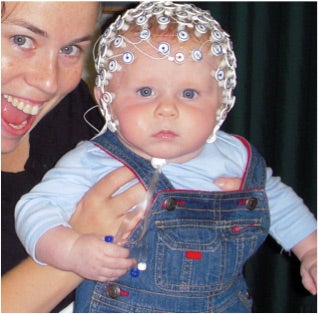|
December 11, 2012
Infants process faces long before they recognize other objects, Stanford vision researchers find
Using brain-monitoring technology, Stanford psychology researchers have discovered that infant brains respond to faces in much the same way as adult brains do, even while the rest of their visual system lags behind. By Max McClure

Using a net of electroencephalographic sensors, the researchers noninvasively measured the electrical activity of participants' brains. (Photo courtesy of the Stanford Vision and NeuroDevelopment Lab)
Any mother will tell you that infants love staring at faces. It isn't just parental wishful thinking, either; studies show that babies, even those less than an hour old, tend to stare at face-like images longer than at any other pattern.
But this preference is a little surprising – newborns' visual systems aren't yet fully developed, and infants often have trouble distinguishing between basic shapes. How can they zero in on something as complex as a face?
New research from psychology Research Professor Anthony Norcia and postdoctoral fellow Faraz Farzin, both of the Stanford Vision and NeuroDevelopment Lab, suggests a physical basis for infants' ogling. At as early as four months, babies' brains already process faces at nearly adult levels, even while other images are still being analyzed in lower levels of the visual system.
The results fit, Farzin pointed out, with the prominent role human faces play in a baby's world.
"If anything's going to develop earlier it's going to be face recognition," she said.
The paper appeared in the online Journal of Vision.
The researchers noninvasively measured electrical activity generated in the infants' brains with a net of sensors placed over the scalp – a sort of electroencephalographic skullcap.
The sensors were monitoring what are called steady state visual potentials – spikes in brain activity elicited by visual stimulation. By flashing photographs at infants and adults and measuring their brain activity at the same steady rhythm – a technique Norcia has pioneered for over three decades – the researchers were able to "ask" the participants' brains what they perceived.
When the experiment is conducted on adults, faces and objects (like a telephone or an apple) light up similar areas of the temporal lobe – a region of the brain devoted to higher-level visual processing.
Infants' neural responses to faces were similar to those of adults, showing activity over a part of the temporal lobe researchers think is devoted to face processing.
Infants were "not yet face experts like adults," Farzin said, "but well on their way."
Objects, on the other hand, lit up a lower-level area of the visual system – a part of the occipital lobe devoted to processing more basic visual features such as contrast or orientation.
The researchers can't yet say, however, whether this early jump on face recognition is intrinsic or the result of infants encountering faces over and over again in their daily life.
The context in which babies encounter faces is very different than it is for objects, Norcia pointed out. "When you see a face, you're looking at your mom, you're interacting," he said. "It's associated with a reward."
The findings may also have significance for a class of neurological and neurodevelopmental conditions that cause lifelong struggles with facial recognition. The difficulties are associated with restricted oxygen flow or trauma to the brain shortly after birth or atypical early development of the face-specific brain region.
The work was supported by a postdoctoral training award from the National Institutes of Health.
-30-
|